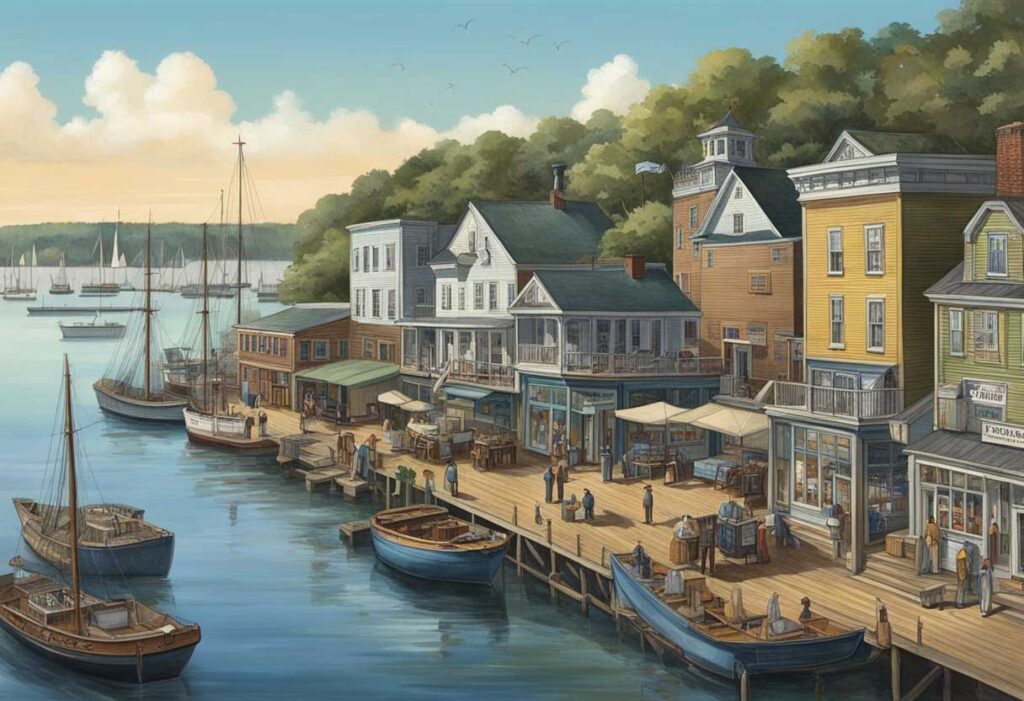Port Jefferson, also known as Port Jeff, is an incorporated village in Suffolk County on Long Island’s North Shore.
Founded in the 17th century, it has evolved from a rural community to a bustling village. The population was 7,962 as of the 2020 United States census.
Originally called “Drowned Meadow” due to its tidal downtown area, Port Jefferson experienced a transformation in the 19th century. A major turning point came when Capt. William L. Jones built a causeway across the 22-acre salt marsh in 1836, eventually turning it into Main Street.
Today, Port Jefferson blends its rich maritime history with contemporary development. Despite significant changes, the village still preserves many aspects of its cultural and historical heritage, making it a unique place in New York.
Key Takeaways
- Founded in the 17th century, Port Jefferson has grown from a rural community into a vibrant village.
- Major development occurred in the 19th century when Capt. William L. Jones built a causeway across a salt marsh.
- The village combines its maritime history with modern development, preserving its cultural and historical heritage.
The Birth and Growth of Port Jefferson
Port Jefferson, initially a humble hamlet, evolved into a bustling village known for its shipbuilding industry and vibrant downtown area.
Settlement and Naming
Port Jefferson began its journey in the 17th century. The Setalcott Indians were the earliest known inhabitants. Later, settlers arrived and established a small community. Initially named Drowned Meadow due to regular tidal flooding, the area underwent significant change in the early 19th century.
John Roe played a pivotal role in the area’s development. Around 1836, Capt. William L. Jones built a causeway across the 22-acre salt marsh, transforming the landscape. Renaming to Port Jefferson honored Thomas Jefferson, recognizing his prominence in American history.
Shipbuilding Prowess
The shipbuilding industry was crucial to Port Jefferson’s growth. Beginning as early as 1797, the village’s first shipyard laid the groundwork for over a century of maritime activity. By the 19th century, Port Jefferson had earned a reputation for crafting robust ships.
The industry thrived until the 1920s, employing many villagers and contributing significantly to the local economy. Shipyards lined the waterfront, and the community grew around this bustling industry, setting the stage for future prosperity even after the industry’s decline.
Downtown Development
The transformation of East Main Street was instrumental in shaping today’s Port Jefferson. Once a tidal marsh, it became a central hub following extensive filling and construction efforts initiated in the mid-1800s. Capt. William L. Jones’s causeway was pivotal in this change.
Downtown Port Jefferson now boasts historical buildings, commercial establishments, and residential areas. The combination of old and new creates a unique charm. The Port Jefferson Historical Society highlights these transitions, offering glimpses into the past while promoting community identity. This vibrant downtown continues to be a testament to the village’s dynamic history and growth.
From Maritime to Modern
Port Jefferson transitioned from a bustling shipbuilding center to a vibrant tourist-based economy. This shift transformed the community, introducing new educational foundations and attractions.
Decline of Shipbuilding
The downfall of the shipbuilding industry began around the 1920s. Advances in ship construction materials and methods led to a decreased demand for wooden ships, which had been the mainstay of Port Jefferson’s economy. Many shipyards closed, leading to reduced local employment.
Greater Port Jefferson region felt the economic impact. Residents had to seek new opportunities as the maritime industry waned. Despite the decline, remnants of this period remain, like historical landmarks and museums that celebrate the maritime heritage.
Transition to a Tourist Economy
As shipbuilding declined, Port Jefferson gradually evolved into a tourist destination. The scenic harbor, influenced by its maritime past, attracted visitors seeking a coastal experience. New businesses, restaurants, and shops sprouted to serve tourists.
Efforts to promote the downtown area included events and festivals, drawing more visitors annually. Visitors can explore historic sites, dine at local eateries like 5th Season Restaurant, and enjoy the scenic views. Port Jefferson Station also benefited from increased traffic and investment, further supporting the local economy.
Educational Foundations
Education played a critical role in sustaining the community through its transformations. Port Jefferson School District expanded, adapting to the new economic landscape. Schools focused on providing diverse educational opportunities to prepare students for various careers.
Additionally, educational initiatives emphasized the area’s history and maritime roots. Local libraries and historical societies, such as the Port Jefferson Historical Society, offered programs and resources to educate residents about their heritage. These efforts ensured that while the community modernized, it never forgot its rich past.
By integrating tourism and education, Port Jefferson successfully navigated its transition and continued to flourish.
Cultural and Historical Heritage
Port Jefferson’s rich cultural and historical heritage is showcased through its museums, historical society, and preservation efforts. These highlights give insight into the area’s significant past and ongoing efforts to maintain its historical essence.
Mather House Museum and Complex
The Mather House Museum, situated in the village, offers a glimpse into the life of shipbuilder John T. Mather. The home, dating back to 1840, stands as a preserved relic of his legacy. Inside, visitors can find antiques, period furniture, and paintings by William Davis that depict the local boat-building history.
The museum complex doesn’t just include the house itself. It also contains exhibits on Long Island history and the village’s once-thriving shipbuilding industry. These exhibits offer in-depth information and include documents, photographs, and artifacts related to the area’s past.
Historical Society of Greater Port Jefferson
Founded in 1967, the Historical Society of Greater Port Jefferson plays a crucial role in preserving the village’s history. Its mission is to discover and safeguard knowledge about the greater Port Jefferson area. The society operates the Mather House Museum and spearheads various historical initiatives.
The society regularly hosts events, tours, and educational programs to engage the community. Their efforts ensure that the history and cultural significance of Port Jefferson are passed down through generations, making history accessible to both residents and visitors.
Preserving the Historic District
The village’s historic district is actively preserved to maintain its distinct architectural and cultural heritage. Efforts focus on the conservation of notable structures and the character of old Port Jefferson. Specific grants, like those from the Gardiner Foundation, have funded restoration projects on key buildings, such as the John T. Mather 1840 Home and the consignment shop, which now boasts a historically accurate cedar shingle roof.
Preservation also involves maintaining a comprehensive archive of historical materials. These archives include brochures, documents, and photographs that document the village’s history and evolution. Through these efforts, Port Jefferson continues to celebrate and protect its historical legacy.
Contemporary Port Jefferson
Port Jefferson continues to be a vibrant community with a rich blend of economic activities and attractions. The village offers a unique lifestyle characterized by a mix of historical charm and modern amenities.
Economic and Community Landscape
Port Jefferson’s economy is dynamic and diverse. The village hosts various businesses, from antiques shops to modern boutiques. The local economy benefits from the Bridgeport & Port Jefferson Ferry, which provides a crucial transport link to Connecticut. This ferry not only boosts tourism but also facilitates commerce between the states.
The marina is another significant aspect, accommodating numerous boats and contributing to the maritime economy. Community events and businesses often feature on the village website, which serves as a key hub for information and contact details.
Port Jefferson’s Attractions and Lifestyle
The village offers an enjoyable lifestyle with many attractions. For dining, there are various restaurants, offering diverse culinary experiences. These dining spots often use local ingredients, adding to the charm.
Leisure activities include visits to historical sites, as highlighted by the village historian. These sites are accessible and offer a glimpse into the rich past of Port Jefferson.
Finally, the Bridgeport & Port Jefferson Ferry and the marina provide unique recreational opportunities like boat tours and fishing, adding to the lifestyle and appeal of the area.
Frequently Asked Questions
This section explores key historical events, contributions, notable associations, landmarks, and historical dining establishments in Port Jefferson, NY. Information about its role in Suffolk County is also included.
What are the key historical events that shaped Port Jefferson, NY?
Port Jefferson, originally called Drowned Meadow, was first settled in the 17th century. The downtown area’s transformation began in 1836 when Capt. William L. Jones built a causeway across the salt marsh, later filled in to create Main Street.
How has the Port Jefferson ferry contributed to the area’s development?
The Port Jefferson ferry, connecting to Bridgeport, Connecticut, has been pivotal in promoting commerce and tourism. By providing a key transportation link, the ferry has significantly boosted local businesses and improved accessibility to the area.
Can you outline the historical significance of PT Barnum’s association with Port Jefferson?
Showman P.T. Barnum, known for his circus, had investments in the Port Jefferson ferry and real estate. His involvement helped promote the village and attracted visitors, contributing to its development.
What are the prominent landmarks and attractions in Port Jefferson, NY?
The Mather House Museum, once home to shipbuilder John T. Mather, is a notable landmark. Other attractions include the Port Jefferson Historical Society and the waterfront, which offers scenic views and recreational activities.
How does Port Jefferson, NY fit into the history of Suffolk County?
As an incorporated village within the town of Brookhaven, Port Jefferson has played a significant role in Suffolk County’s maritime history. The village’s shipbuilding industry, which thrived from the late 18th century, is a key historical aspect.
What are some of the historical dining establishments in Port Jefferson?
Port Jefferson hosts several dining establishments with historical significance. Some of these have been serving patrons for decades, offering a blend of local cuisine and heritage. Notably, these establishments add to the village’s charm and appeal.










